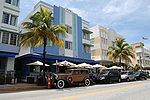The Tides (Miami Beach)
1936 establishments in FloridaBuildings and structures completed in 1936Residential skyscrapers in Miami Beach, Florida

The Tides is a building in Miami Beach. As a 49-meter building in 1936, it was the tallest in the city and one of the tallest in the state of Florida. The building was renovated in 1997, and is currently a residential condominium. and luxury hotel. It was previously operated by the Chris Blackwell resort group Island Outpost. Since being operated by Island Outpost, it has had multiple owners and is currently the King & Grove Tides South Beach The picture here is not the Tides Hotel. It is the nearby Netherlands Condominium.
Excerpt from the Wikipedia article The Tides (Miami Beach) (License: CC BY-SA 3.0, Authors, Images).The Tides (Miami Beach)
Ocean Drive, Miami Beach
Geographical coordinates (GPS) Address Nearby Places Show on map
Geographical coordinates (GPS)
| Latitude | Longitude |
|---|---|
| N 25.783121 ° | E -80.130351 ° |
Address
Ocean Drive 1220
33139 Miami Beach
Florida, United States
Open on Google Maps









